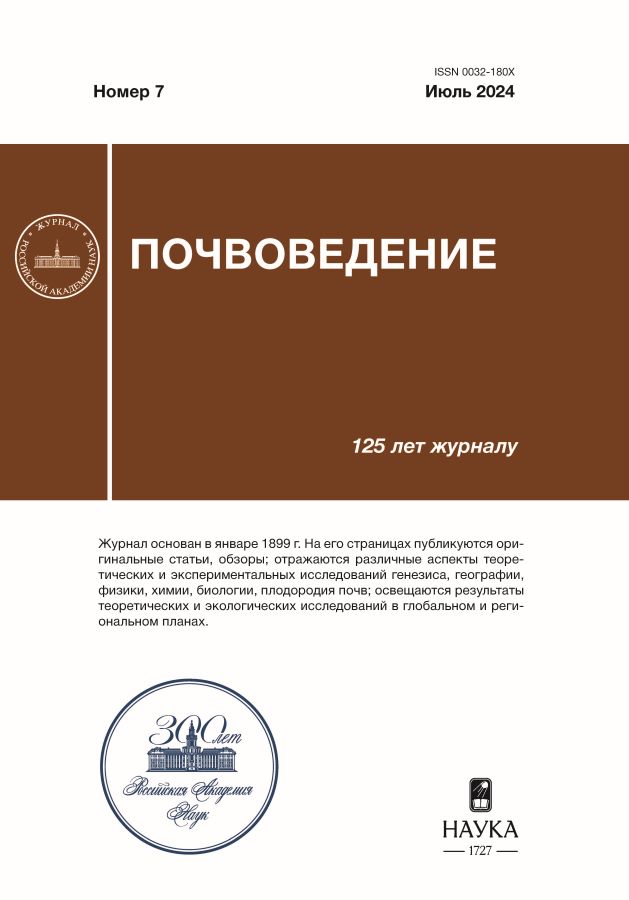Water-Extractable Organic Matter of Soils with Different Degrees of Erosion and Avulsion in a Small Catchment in the Central Forest-Steppe of the Central Russian Uplands: Soil Sediments at the Dry Valley Bottom
- 作者: Kholodov V.A.1, Yaroslavtseva N.V.1, Ziganshina A.R.1, Danchenko N.N.1, Danilin I.V.1, Farkhodov Y.R.1, Zhidkin A.P.1
-
隶属关系:
- Dokuchaev Soil Science Institute
- 期: 编号 7 (2024)
- 页面: 921-935
- 栏目: SOIL CHEMISTRY
- URL: https://kld-journal.fedlab.ru/0032-180X/article/view/666612
- DOI: https://doi.org/10.31857/S0032180X24070018
- EDN: https://elibrary.ru/XVMYZQ
- ID: 666612
如何引用文章
详细
We studied the composition of water-extractable organic matter (WEOM) of reclaimed soils (Novic Protocalcic Chernozems) in the unplowed bottom of the dry valley and to compared it with the composition of WEOM of the plowed soils (Protocalcic Chernozems) on cropland in the small catchment. A layer-by-layer study of the composition of the WEOM of reclaimed soils was carried out from the surface to a depth of 120 cm with a step of 20 cm. Aqueous extracts were characterized by the content of organic carbon, nitrogen and pH value. The optical properties of WEOM were assessed by spectrophotometry and fluorescence spectroscopy. The optical properties of WEOM of Protocalcic Chernozems were compared with those of sediments. The features of changes in these properties with depth in sediments were also analyzed. It was revealed that erosion-accumulation processes have a significant impact on the composition of soil WEOM. The content of dissolved carbon in WEOM does not differ significantly either between arable chernozems and sediments, or along the depth of the vertical profiles of sediments. At the same time, content of nitrogen WEOM in the arable chernozems is generally higher than in the sediments, and in the sediments it naturally decreases with the depth. Probably the decrease of nitrogen content of WEOM with the depth of sediments is associated with its absorption by plant roots and with an increase with the depth in the proportion of anaerobic zones where denitrification processes are activated. The top 0–60 cm of soil sediments actively retain nutrients leached from arable soils, primarily dissolved nitrogen. This process promotes the accumulation of carbon in the underlying layers. The increase in the content of total organic carbon in Novic Protocalcic Chernozems layers deeper than 60 cm can be explained by the accumulation of DOM penetrating from above. DOM in the lower layers of Novic Protocalcic Chernozems, on the one hand, is sorbed by the soil, and on the other hand, it is preserved due to a decrease in microbial activity due to a lack of nutrients.
作者简介
V. Kholodov
Dokuchaev Soil Science Institute
编辑信件的主要联系方式.
Email: vkholod@mail.ru
ORCID iD: 0000-0002-6896-7897
俄罗斯联邦, Moscow
N. Yaroslavtseva
Dokuchaev Soil Science Institute
Email: vkholod@mail.ru
俄罗斯联邦, Moscow
A. Ziganshina
Dokuchaev Soil Science Institute
Email: vkholod@mail.ru
俄罗斯联邦, Moscow
N. Danchenko
Dokuchaev Soil Science Institute
Email: vkholod@mail.ru
俄罗斯联邦, Moscow
I. Danilin
Dokuchaev Soil Science Institute
Email: vkholod@mail.ru
俄罗斯联邦, Moscow
Yu. Farkhodov
Dokuchaev Soil Science Institute
Email: vkholod@mail.ru
俄罗斯联邦, Moscow
A. Zhidkin
Dokuchaev Soil Science Institute
Email: vkholod@mail.ru
俄罗斯联邦, Moscow
参考
补充文件
















